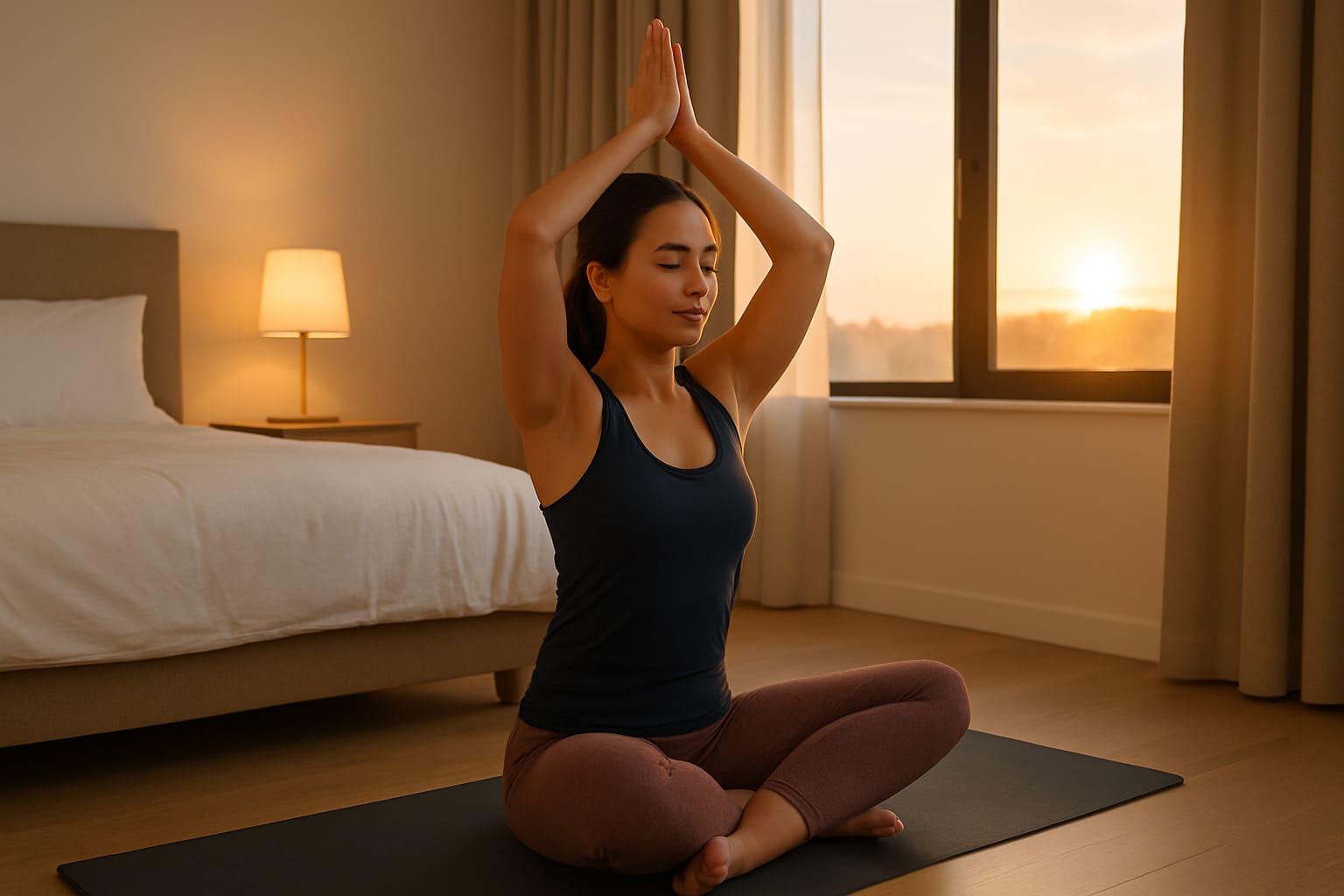Skin diseases are one of the most dreadful medical conditions anyone can ever have. They may not be life-threatening, but they can mar your appearance and dampen your self-confidence for life. Psoriasis is an example of a skin disease that you don’t want to ever have. Not only is it chronic, but also difficult to treat. However, with the acupressure points for psoriasis, you can be able to effectively manage symptoms of psoriasis.
Psoriasis is a skin disease that is characterized by red itchy, scaly patches. For most people, these itchy scaly patches appear on the knees and elbows, while for others, it appears in their trunk and scalp. The evil thing about psoriasis is that it is chronic, and it has no identifiable medical cure. In other words, seeing your doctor may not change anything.
I am talking about psoriasis today because it is a prevalent skin disease for both genders of any age. According to recent statistics, 3% of the population of the USA, which is about 7.5 million adults in the USA, have psoriasis.
In this article, I’m restoring your hope through acupressure. I’ll discuss the various causes of psoriasis and the pressure points that can help you manage your psoriasis symptoms based on these causes.
Is Acupuncture Therapy Effective In Treating Psoriasis?
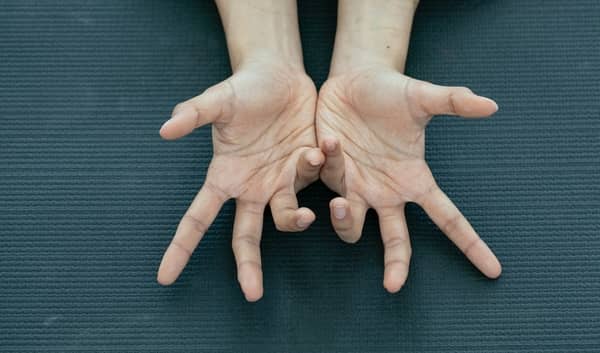
Like I mentioned earlier, there is no clear contemporary medical treatment for psoriasis. For this reason, so many people have turned their focus on acupuncture because of its effectiveness in treating a variety of diseases. Acupuncture, as always, is a worthy solution to psoriasis, and there are studies to back this claim.
A 2017 study found that acupuncture-related techniques proved effective in the short term as an alternative therapy in the treatment of psoriasis. It recommended acupressure and acupoint catgut embedding. Another study suggested that acupuncture needling, electroacupuncture, and fire needling are effective in improving the wounds that come from psoriasis. It highlighted that electroacupuncture was more responsive in reducing the inflammatory symptoms of psoriasis.
A third study focused on using acupuncture to treat Psoriasis Vulgaris. The result of the research showed that the use of acupuncture in treating Psoriasis Vulgaris is promising and needs further research.
Acupuncture and acupressure therapy comes off as a useful treatment to psoriasis because it helps relieve stress, which is a common trigger of psoriasis flares. These therapies are also effective in relieving pain, which is a major challenge in psoriatic arthritis.
The Acupressure Points For Psoriasis
In Traditional Chinese Medicine (TCM) there are five types of psoriasis. My discussion on the acupressure points for psoriasis is based on these types of psoriasis.
Type 1
The first kind of psoriasis in TCM is a result of the accumulation of dampness and heat in the body, which is worsened by bathing, eating, or drinking. When you have this kind of psoriasis, you’ll notice symptoms like dullness, hot flashes, bad breath, pimples, swelling, etc. At this point, it’s best to avoid taking alcohol or greasy foods as they will worsen and prolong your issue. Instead, locate acupoint LI-11 and stimulate it.
Acupoint: LI-11 (Other Names: Large Intestine-11/Qu Chi/Pool at the Crook)
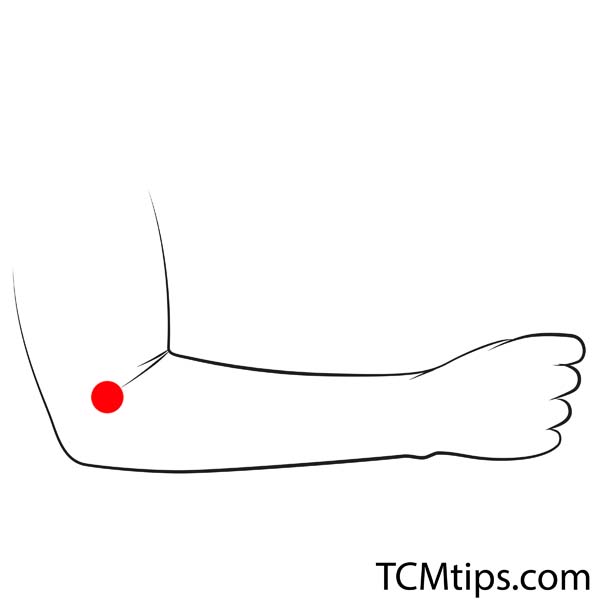
Acupoint LI-11, also known as Quchi in Chinese Medicine, is the effective acupressure point for skin psoriasis as a result of dampness and heat. It is a large intestine pressure point that is located in the elbow. You’ll find it at the point where the crease formed when you bend your elbow ends.
Because LI-11 functions as an expeller of heat and resolver of dampness, it is also used clinically to treat issues like sore throat, malaria, abdominal pain, headache, and irregular menstruation. It is also one of the acupressure points to reduce arm fat.
Type 2
Another type of psoriasis in TCM is the type that occurs as a result of your blood heating up and your skin itching at night, which may cause bleeding when you scratch it. If this is your case, you’ll notice symptoms like fever, hot flashes, red-eye, headache, irritability, constipation, abnormal bleeding, etc. At this point, avoid binge eating, eating spicy foods, and stress and stimulate acupoint SP-10.
Acupoint: SP-10 (Other Names: Spleen-10/Xue Hai/Sea of Blood)
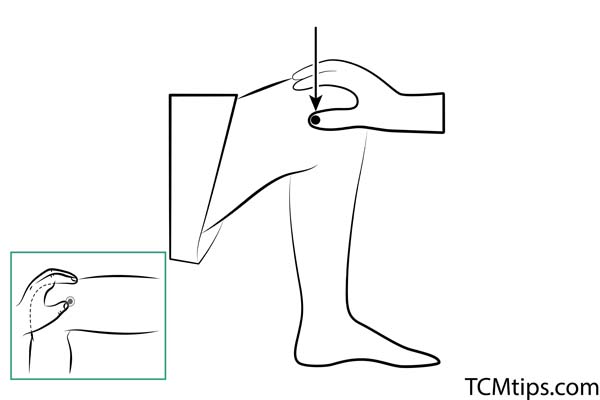
Acupoint SP-10 or Xuehai is the right acupressure point for psoriasis caused by heated blood and itching. SP-10 is located in your upper leg. To locate it, bend your knees ninety degrees and place three fingers above your knee cap. The point on your thigh where the third finger rests is SP-10.
In TCM, SP-10 is the acupoint for treating blood-related disorders. Therefore, in addition to psoriasis caused by overheating blood, SP-10 is also used to treat irregular menstruation, eczema, and urticaria. It also serves as one of the acupressure points for white patches.
Type 3
The third type of psoriasis in TCM is that which is caused by lack of blood. In this case, the skin is malnourished and becomes rough, dry, and itchy. This will then lead to dizziness, lightheadedness, pale complexion, eyestrain, insomnia, etc. If this is your case, locate and stimulate ST-36.
Acupoint: ST-36 (Other Names: Stomach-36/Zu San Li/Leg Three Miles)
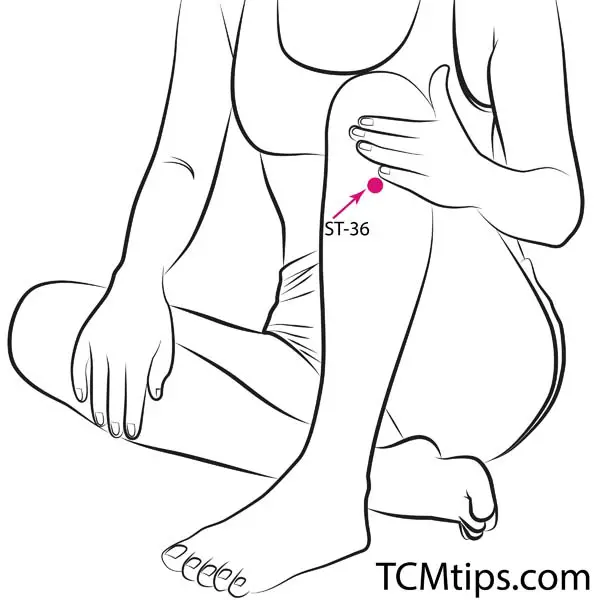
Zusanli or ST-36 is the perfect acupressure for psoriasis as a result of lack of blood. It is a stomach meridian acupressure point that is located in the leg. To locate ST-36, simply place four fingers at the end of your knee. The depression between the bone and muscle where the fourth finger rests is ST-36.
Because ST-36 is responsible for tonifying Qi and restoring general wellness, it is also used clinically to treat gastric pain, vomiting, pain in the knee joint, and asthma. ST-36 is among the pressure points to increase blood circulation in the feet.
Type 4
The fourth type of psoriasis is caused by a weakened gastrointestinal tract and lack of energy. These challenges then disrupt the balance of the skin’s immune system. As a result, you’ll notice symptoms such as loss of appetite, sleepiness after eating, loose stools, bloating, tiredness, swelling, etc. Also, the nature of this kind of psoriasis makes you sensitive to sunlight, cold, and heat, making you sweat a lot. To remedy this, stimulate Ren-12.
Acupoint: Ren-12 (Other Names: The Conception Vessel-12/Zhong Wan/Middle Epigastrium)
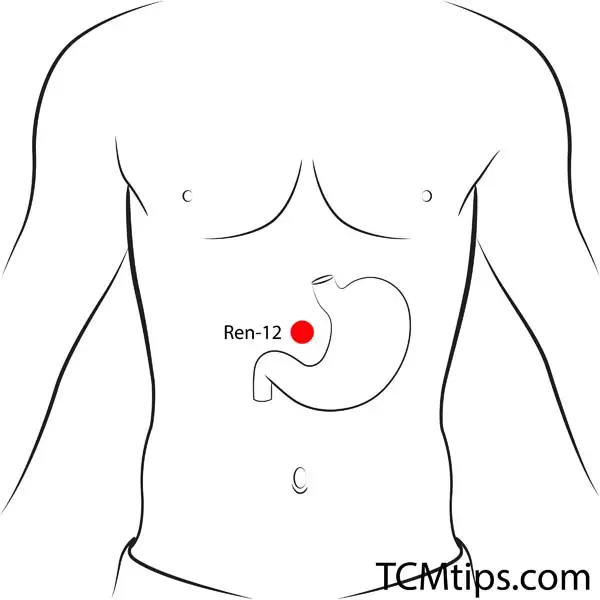
Ren 12, also known as Zhongwan in Chinese, is another of the acupressure points for psoriasis. You’ll find this acupoint on your stomach. To locate Ren-12, simply place four fingers above your navel. The point where your index finger rests is Ren-12.
Due to the harmonizing of the spleen and stomach function of Ren-12, this acupoint can also be used to treat cough, diarrhea, abdominal distention, and epigastric pain. It is also one of the acupressure points for eczema.
Type 5
The last kind of psoriasis in TCM is caused by poor blood circulation. This makes your skin darken and causes pigmentation to remain even after healing. This kind of psoriasis comes with stiff shoulders, headache, bad lip color, noticeable stains and dullness, hot flashes, etc. Inflammation, stress, and cold can worsen this kind of psoriasis and make it difficult for you to discharge waste from your body. Don’t worry. All you need do is stimulate SP-6.
Acupoint: SP-6 (Other Names: Spleen-6/San Yin Jiao/Three Yin Intersection)
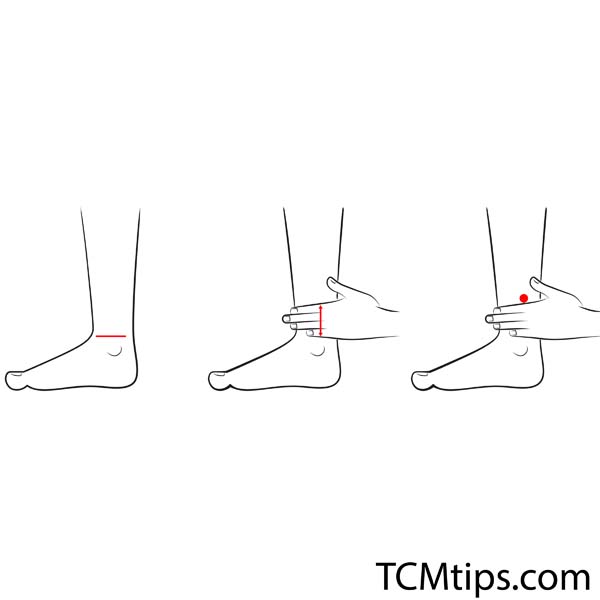
SP-6 is a spleen meridian pressure point that serves as one of the acupressure points for psoriasis. It is called Sanyinjiao in Chinese and is located on the leg. It is the point in the middle of your lower leg when you place four fingers above the rise of your ankle.
In addition to treating psoriasis, you can also stimulate SP-6 when you have irregular menstruation, urticaria, diarrhea, foot paralysis, and abdominal distention. SP-6 also serves as acupressure for circulation in the hands.

Try our Anti-Aging Gua Sha Tool designed to bring out your skin’s natural glow.
Best Gua Sha Product- Anti-Aging: The tool is designed to target 11 specific aging signs such as wrinkles and sagging skin. By following the 7-step routine, users can improve skin firmness and reduce fine lines naturally.
- Enhances Skincare Routine: It works effectively with serums and lotions, boosting absorption and efficacy of skincare products.
- Visible Skin Improvement: Users can expect a smoother complexion, reduced puffiness, and a more youthful appearance.
 P. Sze
P. Sze 


